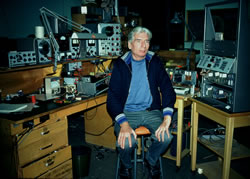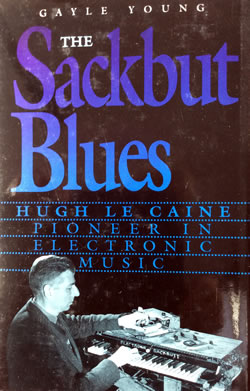Interview with Gayle Young, Le Caine Biographer
Seeing down to the fundamentals of sound with Hugh Le Caine
In October 2013, Ryan Paul Gibson (in the Ottawa CBC studios) did a remote interview with Gayle Young (in CBC’s Hamilton studios) in view of a piece he was doing on Hugh Le Caine entitled “MODULO — Ottawa’s Synth Secret.” This radio production, a lead-up to the premiere of a documentary he was producing for Travis Boisvenue entitled MODULO, was aired on “All In A Day” on 25 October 2013. 1[1. Both of these pieces are found in Boisvenue and Gibson’s “MODULO: A musical documentary and tribute to Hugh Le Caine,” also published in this issue of eContact!] The following text is a transcript of the original audio of the interview (Audio 1) with only slight revisions in view of its online publication in eContact!
Gayle Young studied contemporary music with David Rosenboom, Richard Teitelbaum, James Tenney and Bob Becker at Toronto's York University (1974–77) and was soon presenting concerts as composer and performer of microtonal music on acoustic instruments of her own design, both stringed and percussion. She also composes for orchestral and electronic instruments, and pre-recorded soundscapes. Young has written extensively on contemporary music and sound arts. The Sackbut Blues, her biography of Hugh Le Caine, describes interconnections among physics, acoustics and music from a mid-twentieth century perspective. Young is the publisher (and former editor) of Musicworks Magazine. Her compositions have been broadcast and performed internationally, and she has received numerous awards and commissions, most recently a prestigious fellowship in 2014 with Civitella Ranieri Foundation for a six-week residence in Italy, where she completed As Trees Grow, for piano and optional electronics.
http://www.gayleyoung.net
[Ryan Paul Gibson] So talk a bit about who he was, from what you know. Who was Hugh Le Caine?
[Gayle Young] He grew up in Port Arthur, which is now Thunder Bay [in Northern Ontario], and he was very interested in sound and science and music. He played violin and piano and ukulele, etc. He also built sound-making devices. When he was very young, his father was one of the engineers at the grain elevators. He grew up in early twentieth-century technology and started to transfer it to sound when he was very young. But then he had the historical coincidence of going to the university during the Depression in the 1930s — he chose to study physics rather than music [in order to qualify for a paying employment]. He loved music, he loved science, he knew a lot more about it than most people and he was just very excited about what he was doing.
Did he spend his whole career doing it?
Well, he had other jobs, especially when he was younger: he worked on radar development, he worked in atomic physics and he worked in microwave radio transmission, to name three, as a scientist at the National Research Council.
Why was he important to the history of electronic music?
He was one of the first people to transfer the knowledge that had been gained, through science and technology, into the musical area. For instance, he worked with waveforms in atomic physics, he worked with waveforms in microwave radio transmission. But all those waveforms were either too high or too low to be heard by humans, really; they were outside the human pitch range. So he transposed them down into the pitch range and then used techniques like frequency modulation [FM], which is a radio technology, to affect the sound.
A lot of people I have spoken to have called him a “pioneer”. Is that how you would characterize him?
Yes, I would, definitely. He was innovative in so many ways — he was able to see right down to the fundamentals of the sound. In fact, one of the reasons his instruments weren’t commercially manufactured was because they were too different from the standard methods of doing things at the time. Factories would have had to rebuild a lot of their basic fabrication processes to accommodate his instruments. The reason for that was because he understood sound — physics, perception, engineering — at a very fundamental level. That was one of the reasons he could be such an important pioneer, because he brought up new ideas that people had not been able to accomplish before, and in some cases hadn’t thought of before.

Have you ever seen photos of the NRC music lab, or his work area?
Yes, it was quite a large area, and it had lots of projects going on simultaneously. It was in a building called the Radio and Electrical Engineering Division, on the outskirts of Ottawa.
What was it like inside?
Well, it was a lab, so it was clean [and had] tiled floors. He had technical support there, two, sometimes three people working on projects with him. He often worked all night though, so he didn’t have support at that time.
Do you know how many inventions that he did craft or create during his time there?
I have a copy of the biography here. I’ll see how many instruments are listed in the appendix; that should pretty much tell us. There are 22 listed here as instrument names, and on the other page there are 9 different devices, like a logarithmic resistor for voltage-controlled oscillator, a glide strip (for the Sackbut), a voltage-controlled amplifier, a voltage-controlled filter, printed circuit keys… These are all components that were used within the instruments and in addition to that there are [more than] 20 separate instruments. 2[2. Many of these are discussed or presented by other authors in this issue of eContact!, but also see the “Hugh Le Caine Photo Album.”]
To your knowledge, what has happened to a lot of his work, the balance of his inventions?
The physical [components] of his inventions are largely at the Museum of Science and Technology in Ottawa, and some of them are on display there. There’s a Sackbut and one of the early Multi-track Tape Recorders on display, and then the rest are in climate-controlled conditions.
Knowing that they are just tucked away in between thousands of other artifacts, how do you feel about that?
Well I’m glad they’re being preserved, because at the time when my friends and I started the research 3[3. For Gayle Young’s book, The Sackbut Blues: Hugh Le Caine, Pioneer in Electronic Music, published in 1989.], we didn’t know if the instruments would be taken apart and used for parts for other instruments, if they would be taking out all the resistors or vacuum tubes, etc. — cannibalizing them, in other words. So they’ve been protected from being cannibalized; you can see exactly what they were like, where everything is supposed to be. The disadvantage is that a lot of the materials [that make up the physical parts of the machinery] don’t age well, especially when they are not being used. For instance, rubber dries up and cracks. But even sliders, if they’re not moved regularly, lose their flexibility — lose their ability to slide, essentially. So, they’re kind of being frozen, in a way, by not being used. But you also have to contrast that with the fact that it’s really hard to get vacuum tubes and plug them into the instrument. Often if you fix one thing, the next thing down the circuit will then go wrong, in an old piece of equipment like that.

Has he kind of been lost in time?
He’s known to people who study the history of electronic music, and science and music, but outside of that very small group he is not known among a large number of people who now play instruments that are similar to what he designed.
Why do you think that is?
I think there are two reasons. One of them was [that] he didn’t have a musician working with him who produced a strong, commercial recording. You can compare that to Switched-On Bach by Wendy Carlos, which made the Moog synthesizer famous. The other reason was that none of the instruments were designed commercially. They were designed in a lab but they were never brought into the commercial design stage, and [they were] not made available for people to buy them.
How would you explain where Hugh Le Caine fits in the history of what you hear now in electronic music, which is pretty ubiquitous? 4[4. See the “Hugh Le Caine Artistic Genealogy 1940–1989” by jef chippewa, also in this issue of eContact!, for a chart showing the branches of Canadian electronic music history that can be traced back directly to Le Caine.]
Hugh was one of the first people who created [devices with which musicians could control more] aspects of the sound than they could on previous instruments. For instance, his 1948 Sackbut — which is now recognized to have been a synthesizer, but of course the word didn’t exist then — had controls for the tone of the sounds, so you could have it sound a little bit like a violin, a little bit like a clarinet, a little bit like an organ (Fig. 2). It also had controls for volume, so you could press the key down harder — touch-sensitive keys weren’t really available until the 1970s — and it had sliders so that you could do the kind of pitch fluctuations that are common for violinists and singers to add expressivity to their [performance], that were not possible at all on [contemporary] electronic instruments, like the Hammond Organ, for instance.

When you sit now and look at his career, what strikes you the most?
The breadth of his understanding of sound is the thing that strikes me the most. He worked with so many different approaches to music, to sound, to organization of sound… I can list a few of them. The synthesizers that I mentioned and the touch-sensitive organ were early in his career. Then later he worked with sine tone clouds, with the serialization of music, the creation of the precursor of the sequencer, very complex machines for working with pre-recorded sounds (which were precursors to sampling machines)… He had a very wide range of thinking and creating about music.
Social top